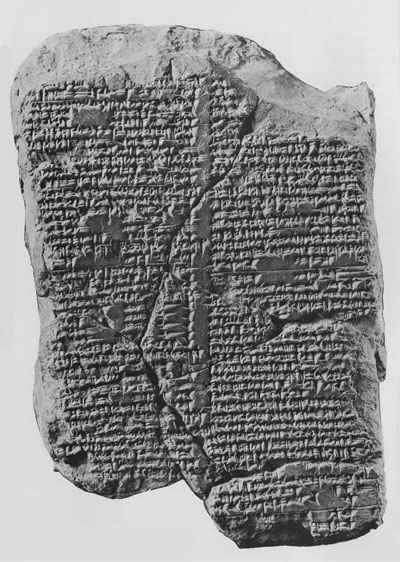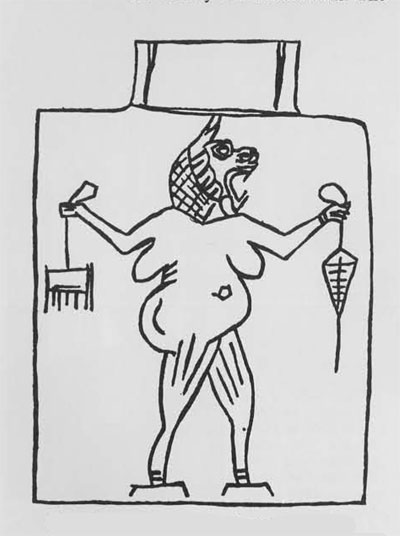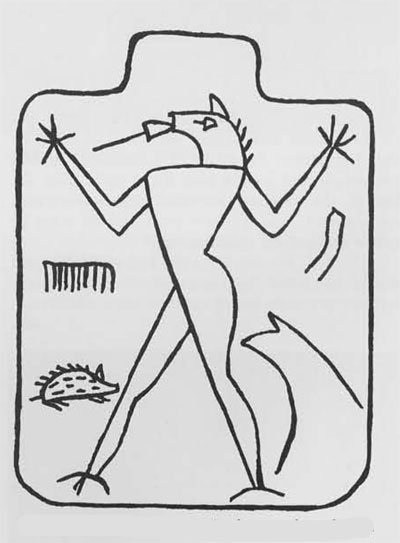One of the major problems in the study of dead civilizations is the lack of native informants. Without such informants it is difficult to recover ethnological data and even more difficult to interpret the data which is recovered. If we wish to understand the dead society and do not wish to resort to spiritualism we must rely on the written and physical remains.

In the case of ancient Mesopotamia, we have a vast corpus of cuneiform documents which can be used to reconstruct ethnology and folklore. In addition, there are large quantities of material remains of all kinds. When these sources are compared with ethnological studies of other societies and careful projections are made, much becomes clear. Conclusions reached in this manner can rarely be proven, but if the study is careful it can contribute to the understanding of ancient society. This paper is concerned with the beliefs and practices surrounding childbirth in the ancient Near East.
Birth in Mesopotamia was a very precarious affair. Due to the lack of proper medicine and medical knowledge, the lack of proper diet, and the lack of sanitation, miscarriages, stillbirths, and infant mortality ran at a very high rate. For the same reasons, death in childbirth was also frequent. The Babylonians and Assyrians felt that these deaths resulted from one of three things: disease, demons, or sorcery. In order to guard against these dangers they built up an extensive collection of incantations, charms, amulets and prescriptions aimed at the protection of both mother and child. Of the three threats, the demons are by far the most interesting.
The mother was susceptible to attack by demons throughout her pregnancy and for a period after she gave birth. During the early months of pregnancy the greatest fear was miscarriage. The texts are not clear as to which demon or demons, if any, were responsible for early miscarriage, but there are numerous rituals to prevent or arrest miscarriage. These rituals are performed directly on the woman and seem to establish disease or sorcery as the causal agent. It seems possible that demons do not enter the picture until later in the pregnancy and that miscarriage in the early stages of pregnancy is attributable solely to disease or sorcery.

At any rate, in the later months of pregnancy and at the time of birth itself the woman and child come under danger from the demon Pazuzu. The full range of activities of this demon is not clear, but he came to attack either the mother or child. In order to defend against him an amulet was made and given to the mother. The amulets were either complete winged figures of Pazuzu or simply heads of the demon. In the case of the heads many were pierced through the ears so they could be worn. Often the amulets were inscribed with either an incantation against Pazuzu or an abbreviated myth about the demon.
After the birth of the child the woman entered a state of impurity just as during menstruation. During this time both the mother and the child were in extreme danger. This same period of impurity survives in the later Jewish, Christian, and Islamic traditions. In each of these the period is forty days, but we are not told the exact length of time in Mesopotamia. In the Christian tradition this period ends with the churching of the mother at which time thanks is given for her safety. This same time period is reflected in official dogma by the feast of the Purification forty days after Christmas. In the Jewish tradition the mother is ritually cleansed on the fortieth day. The Islamic tradition, which is quite consistent throughout the Islamic world, forces the mother to spend the forty days inside the house and never to leave the side of her child. At the end of the forty days she is ritually cleansed and retakes her position in society. In all three traditions the child is also in danger throughout the forty days. In the case of the Jewish child the greatest danger falls in the first eight days before circumcision, but the danger continues for all forty days. Similarly, in the other two traditions the child is in danger the whole time, but particularly so in the first few days.
During the period of impurity the Mesopotamian child was endangered by the demon Lamashtu. An incantation describes her as follows: “She is fierce, she is raging, she is a goddess, she is dazzling, she is a wolf, the daughter of Anu. Her feet are (the talons) of the Anzu-bird, her hands are filthy, her face is the face of a ferocious lion. She came up from the reed thicket. Her hair falls free. Her breech cloth is cut away. She walks with the tread of an ox, she comes down with the tread of a ram. Her hands seek flesh and blood. She comes in through the window, slips in around the cap of the door-pivot. She enters the house, she goes out from the house. Bring me your sons to suckle, and let your daughters turn to me so my breasts can be placed in the mouths of your daughters.” There are representations of Lamashtu. She appears as a nude, hideous woman with the head of a lion or bird, talons, and long dangling breasts. She slips and slithers through cracks, doorsills, windows, or any small opening. Once inside the house, if she finds the baby alone, she will suckle the child and thus kill it.

Similar demons inhabit the world of the Jew, Christian, and Muslim. In Islamic society a female djinn named Ummu`s-subyan will enter the house of a newborn child and if she finds it alone she will suckle the child and then slip away. As a result of this visitation the child will refuse its mother’s milk and slowly starve to death. A Persian picture of this djinn portrays her with wings, horns, and talons, flying in to suckle a child in its crib.
The same type of demon crops up in Christian folklore from Turkey and the Balkans. The various demons have different names in the different societies, but their role is always to sneak in on the unattended child and strangle it. Whether these demons were called Stryga as in Greece, Albasti in Turkey and Central Asia, or by any number of other names, they are all surrounded by the same traditions and all seem to have an oriental origin. The most obvious, of course, is Albasti which is etymologically related to Lamashtu, as has already been noted by others.
Interestingly enough, the later Jewish tradition dates from Mediaeval times and ascribes the killing and stealing of infants to the demon Lillith—a demon who started out with quite a different character.
In order to protect the child from this most horrible demon the Assyrians and Babylonians relied on magic figurines, amulets, and rituals and incantations. The first line of defense was the house itself and attempts were made to keep her out of the house altogether. One way this could be accomplished was by making figurines of magic dogs with their names scratched on their thighs. These dogs were then buried beneath the threshold or put in the windows where they were supposed to work their magic powers and frighten away all demons. Several such dogs have been found at Nineveh and Nimrud. These apotropaic dogs have such delightful names as: “Don’t hesitate, bark!”; “Don’t hesitate, bite!”; “Dispatch him!”; “His bark is loud”; “The one who drives away the Asakku-demon”; “The one who captures the enemy”; “The one who repulses evil”; “The one who bites his foe”; “The one who brings good luck;” and “The one who drives out evil.”

Museum Object Number(s): B4552
Another way to safeguard against Lamashtu was to exorcise her through sympathetic magic: “You should purify potter’s clay. You should take the clay and make a figurine of Lamashtu. Place it at the head of the sick (child). You should fill a container with ashes and thrust a dagger into it. Place it at the head of the sick (child) for three days. On the third day, in the evening you should take (the figurine) outside and strike it with the dagger and bury it in the corner of the wall. You should draw a magic circle of flour around it. Don’t look back.”
Still another way to afford protection was to make a clay plaque with a picture of Lamashtu on it. The plaques were also inscribed with incantations to conjure the demon. These plaques were then hung in the bedroom where they dissipated the danger. Many such plaques have been found and published and they must have seen frequent usage.
The most common defense against demons was a phylactery. In Mesopotamia simple phylacteries consisted of knotted string and magic stones while more complicated ones contained amulets and charms. Phylacteries were also the most common protection in the Christian, Jewish, and Islamic traditions. These ordinarily consisted of a pouch with verses from the Bible, Talmud, or Quran, but some of them contained stories of the demon’s origin followed by a conjuration. For example, one Greek phylactery contains a very long story of how the demon came to be captured and forced to reveal her magical powers. This story is followed by the conjuration: “0, Evil Spirit! Mayest thou be killed and cursed by the terrible and glorious name of the Trinity, and by the 360 holy fathers of the Council of Nicaea.”
Mesopotamian phylacteries varied widely in manufacture. They ranged from objects inscribed with incantations to simple strings of knotted yarn. A typical sort is described in a ritual against Lamashtu: “You should take seven (strands of) dyed wool, hair from the right side of a donkey, hair from the left side of a jenny, hair from donkey foals, hair from a white pig, beetles (?) from the roads, a tuft of black hair from the right side of the hind legs of a donkey, (and) dry wood from a sub-soil plow and a seeder plow. You should roll three strings and place (them) around his neck.”
Phylacteries were generally placed around the neck of the mother or child or alternatively in the room where the mother and child were confined. Through the efficacy of its charms the phylactery served to keep the demon at a healthy distance.
Demons could also be fended off or exorcised through the use of incantations. This was the least efficient means of protection since the demon could match wits with its human adversary. The demon Lamashtu posed under several different names—seven in all. We are told “Lamashtu, daughter of Anu is her first name; the second is sister of the gods of the streets; the third is sword which strikes the head; the fourth is the one who causes inflammation; the fifth is the goddess whose face is horrible; the sixth is the caretaker; taken by Irnina is the seventh.”
If the demon was conjured by only one or two of her names, she might sneak into the child’s room under the guise of another name and do her worst. The same phenomenon occurs in the later Christian tradition where the demon appears with twelve names, twelve and a half names, or even nineteen names in the various texts. Man’s power over the demon was dependent upon knowing all of its names and including them all in the conjuration. Several mediaeval Christian folk tales exist that tell how the demon was forced to reveal its names to mankind.

In Mesopotamia there were separate incantations for each of the names of Lamashtu in addition to short incantations containing only `abra-cadabra’ and long incantations aimed at the demon in all her aspects. One such incantation describes Lamashtu and then conjures her. “Anu created her, Ea raised her. Enlil alloted her the face of a bitch. (Her) hands are small, (but her) fingers are long (and her) claws are long. Her forearms are dirty. She has entered through the door of the house, she is slipping in through the door socket, she has slipped in through the door socket and is about to kill the baby. She has seized (the child) in the abdomen seven times. Remove your claws! Unloose your arms before the wise magic of the hero Ea overtakes you! The door socket is wide for you, the doors are open. Away! Go out in the steppe. (May) they fill your mouth with dirt, your face with dust and your eyes with finely ground cress seeds. I conjure you by the oath of Ea. May you begone!”
Once the child had passed the most dangerous period during its mother’s period of impurity the greatest threat facing it was the evil eye. The evil eye was a continuing danger throughout a person’s lifetime, but oddly enough, was very little threat during the early days after birth. Because the child was confined to save it from Lamashtu, it was also automatically secure from the evil eye. There were myriad ways to thwart the evil eye, but to investigate them here would be to enter a whole new area.
Instead, it is interesting to see how Lamashtu came into existence. In the Atra-hasis epic we are told that in the beginning the gods had to do all of the work in the world. They soon tired of the situation and rose up in revolt. In order to resolve the situation mankind was created and assigned the onerous duties basic to life on earth. However, the solution was only temporary, for soon a population explosion took place and mankind became an annoyance to the gods. “Not twelve hundred years had passed. The land expanded and the people became many. The land was roaring like a bull. The god was disturbed by their racket.”
To alleviate their discomfort the gods sent the great flood and destroyed everyone except the hero, Atra-hasis. Afterwards the gods repented and regretted the destruction of man. They therefore allowed mankind to flourish on the earth once again. However, they took precautions to prevent their peace and tranquility being shattered in the future. “Furthermore, let there be a third group of people. (Let there be) fertile women and barren women. Let there be the ‘Eradicator’ (a name of Lamashtu) among the people and let her snatch the child from the lap of the mother. Establish ugbabtu-women, entu-women, and igisitu-women and let them be taboo and cut off childbearing.”
I doubt if even the most ardent Malthusian would advocate the resurrection of Lamashtu, but her presence seems to have been effective.
